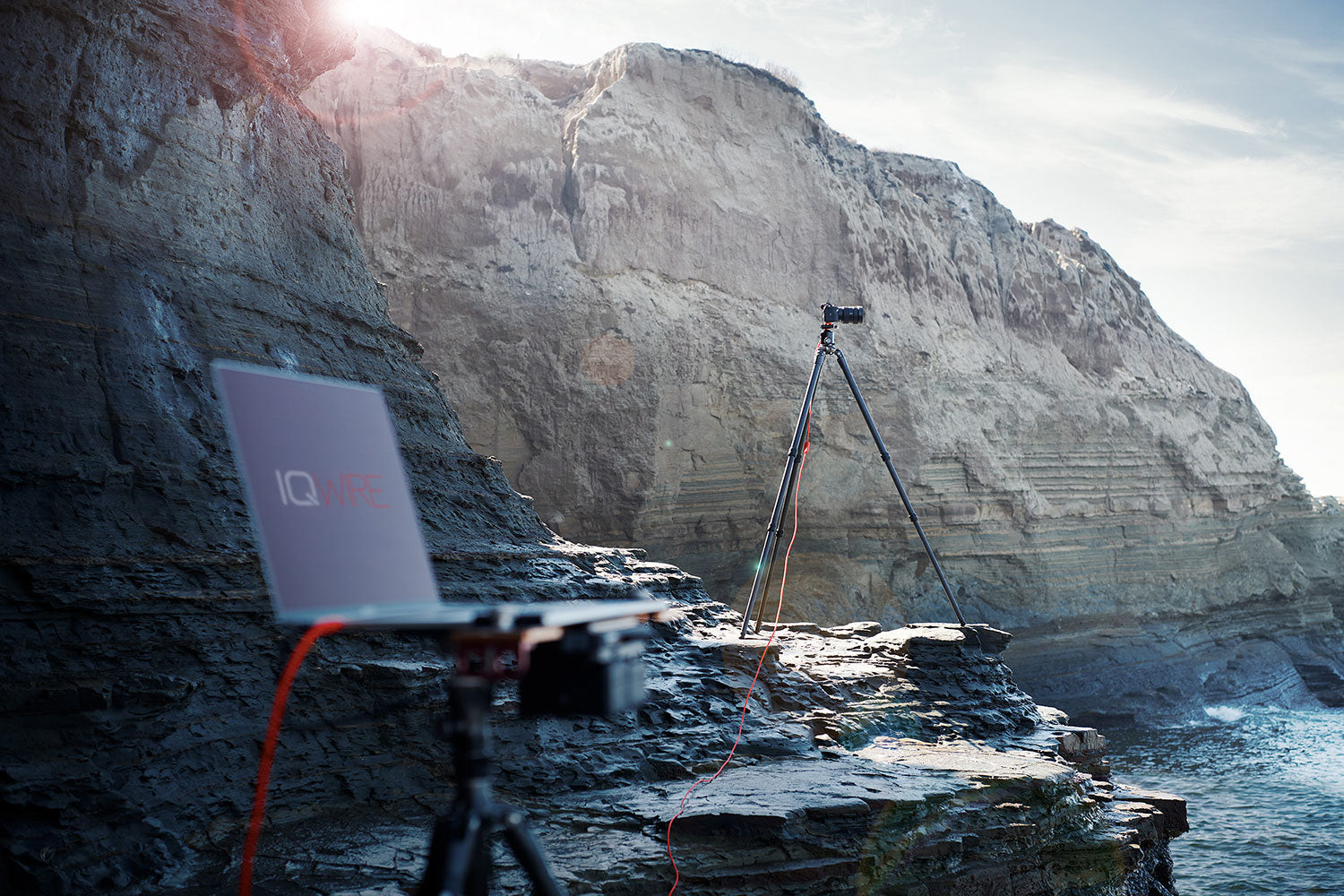[Updated 26 March 2025]
Tethered Photography Introduction
Tethered photography is pretty much standard in professional commercial photography and has even become commonplace for hobbyists. It allows you to see important details and data in your images that you may not see or notice on a small LCD. And when you are collaborating with other creatives, it makes the process go much faster and smoother. Images are now on your computer instead of on a flimsy SD card (the only card type we have ever had fail on us). Backing up files is easy as they now exist on your computer—we keep Apple Time Machine running in the background so we don't even have to think about it. With Time Machine, files are backed up every hour (or you can force a backup at anytime) and it is seamless and fast (a terabyte of images can be backed up in less than 30 seconds). Tethered photography really is the professional workflow.
Tethered Photography Basics
For tethering software, Capture One really is the best option out there. Yes, we all like to flame Capture One when they change features and add more bloatware (which does make the software more unstable), but it is the best capture software and gives the best results when processing high res files. We really don't ever use all the bloatware features that they keep adding so they can release new versions (and, of course, charge you for a new version). For us, Capture One is purely a way to get the files from the camera to the storage device. We have had to help people troubleshoot their cameras with Adobe Lightroom and, at the end of the day, we always shake our head on why anyone would use Lightroom for tethered photography.
For a new setup, here is the quick checklist to get you going.
- Make sure the camera firmware is up to date. Early firmware versions of the D850, R5 and GFX cause headaches especially with long connections. Camera firmware updates are not always released that often but we think you should keep it updated. Always keep all versions of firmware on your computer in case you need to revert at any time.
- Make sure the camera settings are set for tethering. Most cameras defaults are not set for USB tethering but rather just file transfer and the camera shows up on your computer like a hard drive. Each camera is different so you will have to consult your manual for camera tethering settings.
- Make sure capture One is up to date. This can be debatable as there are many digital techs that never use the latest release of Capture One for fear of instability. Some techs will even only use a previous version (like Capture One 12 instead of 13). In recent times, we have found that being on the latest release of Capture One is the best way to go. Camera firmware and Mac OS updates happen so often that it is best to keep Capture One updated so that it can address any changes. As with the firmware, always keep all versions on your computer in case you have to revert.
- Keep it simple. The best practice is to connect your camera straight to the computer and do not use dongles, extensions or hubs. Each time you add another piece to the puzzle, it is just another place for the connection to break down and another element to troubleshoot when you have issues. If you need a long tether cable, just use a long tether cable (like our 33 foot long IQwire)—don't use cable extensions. If you have a USB-C computer, don't use USB-A cables with dongles—again, just another place to break down. Ideally, you are not using your personal laptop for captured photography but rather a dedicated computer just for captured tethering. And keep that computer simple—Capture One and maybe a few apps that you need to use to get your job done. Don't let Adobe Creative Cloud run in the background. Turn off the dumb Twitter app. Keep it simple and you will have less problems down the road.
- Connection sequence is not always relevant but it is a good idea to use a known good protocol and make it a habit:
+ Power on both the computer and camera
+ Connect tether cable to the computer
+ Connect tether cable to the camera - Use a tether block on the camera end (such as IQwire System) and cable management on the computer end. USB connectors are so tiny and fragile and also can lose connection easily just from shifting around in the port. Ideally, you want something on either end of the cable that prohibits the cable from any movement in the port at all. Don't use the tether locks that are merely pieces of string—the cable still moves around quite a bit and will cause problems for you.
Tethered Photography Troubleshooting
Tethered photography is a great tool but can become a nightmare because there are just so many factors involved, nowadays. When you lose connection between your camera and computer, the most likely culprits are (in order of most likely to least likely):
- Capture One
Sometimes just a quit and restart of Capture One solves this. The easiest way to diagnose if it is Capture One is to go to: About This Mac > System Report > Hardware > USB and then check if the computer registers your cable (for a smart cable) and your camera. If you can see your camera in the System Report, then it is Capture One that is most likely the lost connection culprit.
- Mac OS
As the Mac OS becomes more Windows-like, it has so much unnecessary crap going on in the background. A restart is required to fix this but we actually recommend a full Shut Down before powering back up. - Mac Hardware
Sometimes the USB bus just craps out. We are seeing this a lot on the new M1 Macs. The only way to fully reset the USB bus is a full Shut Down—not just a restart. We recommend the full Shut Down because when you just restart, the computer keeps feeding power to the USB bus but when you Shut Down, the entire computer is powered down and everything is reset (for the most part). - Camera
Power off and back on would solve this. - Cable
Yeah, yeah, we make cables, so, of course, we made this the least likely culprit on the list. The cable is usually the first thing that a person blames for a lost connection but it really is usually the last thing to ruin your day. If you think about it, a cable is either going to work or it is not. There can be intermittent issues with a connector but it is rare and most of the time you would just have full failure.
When you lose connection and cannot reconnect, try to eliminate all extra sources of potential conflict. This usually means stripping your system down to computer, cable and camera only after complete system power down and restart. Other peripherals like hubs, hard drives, dongles, etc. can create conflicts with your essential capture components. Sometimes a hard drive in a different port than your tether cable can make the whole USB bus unresponsive or slow. Sometimes that hard drive worked great for two months while tethering but now is creating a conflict. We had a wireless mouse create a conflict with Capture One once.
Slow Transfer Speeds
When your camera connects to your Mac, there is a little negotiation that happens between the two where they agree upon a connection speed. Usually, there is no hiccup and you will get a full USB 3.1 connection at 5Gbps (sometimes it will say 10Gbps but it will still be transferring at 5Gbps). If you suspect you are getting slow transfer speeds, open the USB section in the System Report and check the speed. If it says 480Mbps, that means your connection is at USB2.0 speeds (really slow). Usually, disconnecting and reconnecting solves the issue. Sometimes a Mac and camera restart are needed to clear the USB bus. Why does this happen? We have no idea and cannot force the problem to happen. We can only speculate that it is a glitch where the computer cannot read the cable speed and just defaults to USB2.0. But we have seen other USB devices on the USB bus create the situation, so, as we stated above, keep it simple and remove all the unnecessary peripherals.
Here are some camera specific troubleshooting tips. We will keep adding to this section as we find new issues. Feel free to send us any tips that you might have.
Fuji GFX 100s
Make sure your settings are:
+ [Wrench Menu] > Connection Setting > Connection Mode > USB Tether Shooting Auto
+ [Wrench Menu] > Connection Setting > USB Power Supply Setting > On (If this is set to Off, you will frequently lose connection.)
Fuji GFX 100 II and 100s II
Change your settings to:
+ [Wrench Menu] > Power Management > Performance > Normal
+ [Zig Zag Double Arrow Menu] > Select Connection Setting > 4: USB Tether Shooting Fixed [3: Auto seems to work fine, too]
+ [Zig Zag Double Arrow Menu] > USB Power Supply/Comm Setting > Power Supply Off/Comm On
Sony A7RV
We are not totally sure what triggers this bug (possibly either the camera sleeping or the computer sleeping) but A7RV will lose tether connection and refuse to reconnect. Restarting CaptureOne, the computer and the camera does not fix it. The fix is to pull the battery out of the camera and reinsert it. You don't even have to restart CaptureOne or the computer. THIS BUG HAS SEEMED TO DISAPPEAR WITH NEWER FIRMWARE UPDATES SO THIS MAY NO LONGER BE AN ISSUE.
Canon R5
You would think that memory cards would have nothing to do with tethered photography since the images are transmitted to the computer and not written to the card. The weirdest report of an unstable connection and fix came to us from a photographer using a Canon R5. They had put a cheap SD card in the camera for some untethered shooting and then when they went back to tethered shooting, the camera kept disconnecting from the computer. They discovered that when that card was in the camera, the tethering became unstable. Simply removing the card or replacing it with a quality card solved the issue. We actually recommend having no memory card in the camera when tethered shooting—we can't confirm this but it feels like the camera tries to use the card as a buffer when tethered and it actually becomes counter intuitive and creates a slower buffer than when you just have no card. With our CXRBON BLXCK cables and no card in an R5, you can rapid fire until your computer hard drive is full—the red buffer light on the camera will not even blink once with this configuration.
Canon 5D Mark IV
Setting the camera to Record to Multiple and putting two cards in the camera will cause the camera to drop connection to the computer. Removing the cards or turning off that setting will fix the problem.
Phase One
Both the XF and IQ backs create errors when the battery voltage drops. The voltage of a battery that is full versus 50% is quite different. So change your battery often with Phase One.
If you have any other tips or tricks or must-do items for tethered shooting that you think should be in this article, reach out and let us know.

